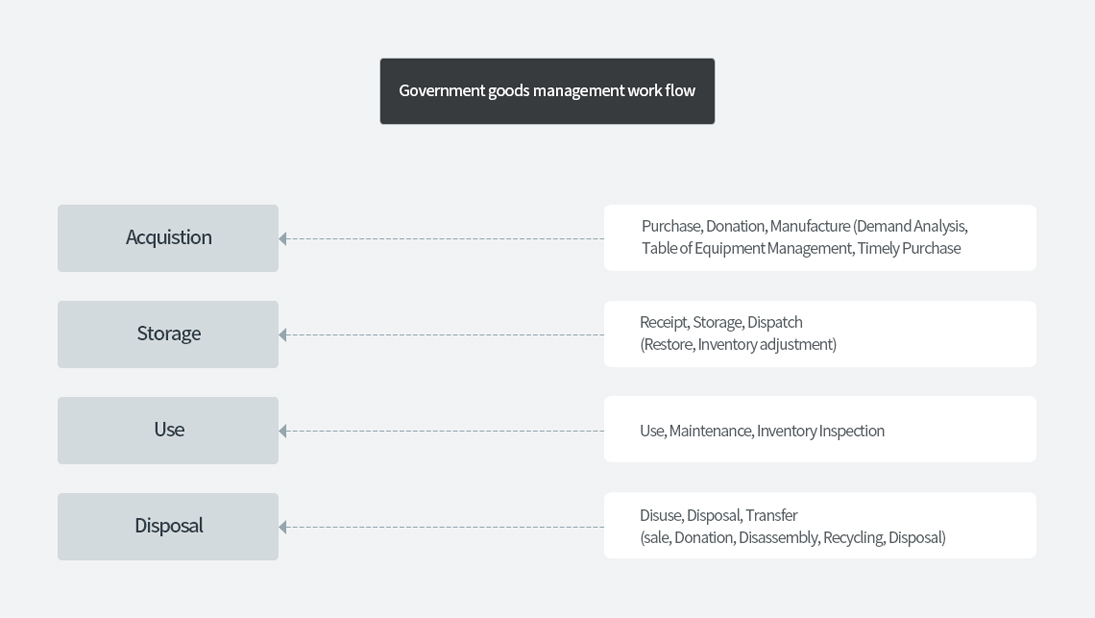- Related sites
- Innovation Marketplace
- Shopping mall
- Venture
- Digital Mall
- Service Mall
- Global Procurement Assistance
- 공사비 정보광장
- Pcae
- ICT Procurement Map
- Stockpile
- Public Procurement Capacity Development Institute
- Public green purchase
- Radio Frequency Identification
- Procurement Information Open Portal
- Technology Evaluation Committee Selection System
- NPIS
- Product Information System
- Local sites
01About PPS
Overview
Government goods management refers to the management of acquisition, active use, and efficient disposal of goods that the government needs in providing administrative services and operating public programs. Efficient management of such goods contributes to enhancing the productivity of administrative activities.
In concert with increasing autonomy and decentralization, government goods management is trending towards increased autonomy by individual government institutions. Consequently, the enhancing the capacity of management officers is growing more important.
With the advancement of information and communication technology, the volume of lease goods and software products used by the government constantly increases. As such goods are not subject to Act on the Management and Use of Information on Commodity Lists, there also arose a need for an efficient management scheme for such goods.
Minister of Strategy and Finance and Administrator of Public Procurement Service (PPS) are responsible for the supervision of nationwide government goods management, while the management itself is under the responsibility of the head of each individual government institution. The head of institution appoints a property management officer to manage the government owned goods under his responsibility.
Minister of Strategy and Finance is responsible for the regulatory framework and policies for government goods management. Administrator of PPS is in charge of overall supervision of government goods management at individual government institutions. If needed, PPS Administrator may request government institutions to submit documentary data on their government goods management for audit and inspection.
PPS's Roles in Government Goods Management
- Establishment and revision of instructions for government goods management procedures, and monitoring on compliance by government institutions.
- Audit and inspection on government goods management by individual government institutions and arranging training programs.
- Comprehensive evaluation of government goods management by individual government institutions and awarding of outstanding performance.
- Measures for disposal of disused goods and promotion of recycling.
Government goods management procedure
Acquisition
For acquisition of goods, budget is allocated and supply management plan is prepared. Contract is established in accordance with the plan, and the contracted good is received after inspection and registered as a government owned property.
For most part, purchasing is the primary means of acquisition. However, it can also conducted by donation, processing and manufacturing as well as transferring the right of use and management responsibility as in cases of use transfer, management transfer, expropriation, etc.
Storage
Inventory officer storages the properties under his responsibility at such government facilities as warehouses and storage yards. Inventory officer may use non-government facilities for the storage of exceptionally heavy or large properties, or for other reasons as the circumstances may require.
Goods must be stored by types for easy management and dispatch, and the storage must be managed in such a way that the goods maintain their use value.
Use
The purpose of acquisition is to actively use the acquired goods to raise administrative efficiency. At the site of use, the management of goods is under the responsibility of property operation officer and the officer who uses the goods.
Equipments should be kept in functional condition and managed efficiently as to minimize the management cost. Efficient use should also be achieved through shared use and proper maintenance.
Disposal
When a property in use or storage becomes no longer needed or become unusable, the head of the institution makes the decision for disuse. For disused items, a survey is conducted to determine whether the item can be utilized at other institutions. Depending on the result, the item is transferred, sold, recycled, disassembled, or disposed and the management for the item is closed.
Inventory Inspection
Inventory inspection verifies the number and condition of government owned goods for the year-end closure of bookkeeping, and inspects the management status. Annual Inventory Inspection verifies the inventory as of the last day of each year, and the head of each institution must submit the inventory inspection report to PPS Administrator by February 20.
Inventory Inspection is conducted under property management officer's responsibility, and the inspection crew should be composed of officers who are not directly involved in government goods management tasks.
RFID-based Technology for Government Property Management
RFID(Radio Frequency Identification)-based government property management systems has been put in place since its initial system development in 2004. As of 2018, RFID technology is currently applied to the entire government properties for efficient management.
In RFID system, each individual item is electronically tagged for identification. The tags can be identified using an RFID reader, and any processes that the item undergoes are automatically recorded in the management system.
By using RFID, each item can be tagged and traced from the point of manufacture. It allows an electronic lifecycle management of government goods from acquisition to disposal, and automatic processing of inventory inspection and disposal of disused items. Also it enables a real-time tracking of various management information.





 Enlarged view
Enlarged view